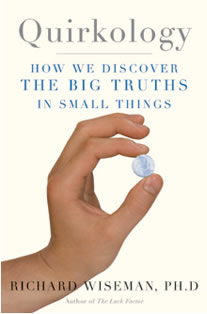EXTRACT
INTRODUCTION
I have long been fascinated by the quirky side of human behaviour.
As a psychology undergraduate I stood for hours in London’s King’s Cross
railway station looking for people who had just met their partners off
a train. The moment they were locked in a passionate embrace, I would
walk up to them, trigger a hidden stopwatch in my pocket, and ask, ‘Excuse
me, do you mind taking part in a psychology experiment? How many seconds
have passed since I just said the words Excuse me..?’. My results revealed
that people massively underestimate the passing of time when they are
in love, or, as Einstein once said, ‘Sit with a beautiful woman for an
hour and it seems like a minute, sit on a hot stove for a minute and it
seems like an hour – that’s relativity’.
An interest in the more unusual aspects of psychology has continued throughout
my career. I am not the first academic to be fascinated by this approach
to examining behaviour. Each generation of scientists has produced a small
number of researchers who have investigated the strange and unusual.
Maverick Victorian scientist, Sir Francis Galton, might be considered
the founding father of the approach, and devoted much of his life to the
study of offbeat topics . He objectively determined whether his colleagues’
lectures were boring by surreptitiously measuring the level of fidgeting
in their audiences, and created a ‘Beauty Map’ of Britain by walking along
the high streets of major cities with a punch counter in his pocket, secretly
recording whether the people he passed were good, medium, or bad looking
(London was rated the best, Aberdeen the worst).
Galton’s work into the effectiveness of prayer was more controversial
. He hypothesized that if prayer really worked, then members of the clergy
– who clearly prayed longer and harder than most - should have a longer
life expectancy than others. His extensive analyses of hundreds of entries
in biographical dictionaries revealed that the clergy actually tended
to die before lawyers and doctors, thus forcing the deeply religious Galton
to question the power of prayer.
Even the making of tea caught Galton’s attention, when he spent months
scientifically determining the best way to brew the perfect cup of tea.
Having constructed a special thermometer that allowed him constantly to
monitor the temperature of the water inside his teapot, after much rigorous
testing, Galton concluded that:
…the tea was full bodied, full tasted, and in no way bitter or flat…when
the water in the teapot had remained between 180° and 190° Fahrenheit,
and had stood eight minutes on the leaves .
Satisfied with the thoroughness of his investigation, Galton proudly declared,
‘There is no other mystery in the teapot’.
On the surface, Galton’s investigations into boredom, beauty, prayer,
and tea-making, may appear diverse. However, they are all excellent and
early examples of an approach to investigating human behaviour that I
have labelled ‘quirkology’.
Put simply, quirkology uses scientific methods to study the more curious
aspects of everyday life. This approach to psychology has been pioneered
by a small number of researchers over the past hundred years, but has
never been formally recognized within the social sciences. These researchers
have followed in Galton’s footsteps, and had the courage to explore the
places where mainstream scientists fear to tread. Academics have:
• Examined how many people it takes to start a Mexican wave in a football
stadium .
• Charted the upper limits of visual memory by having people try to accurately
remember 10,000 photographs .
• Identified the perceived personality characteristics of fruit and vegetables
(lemons are seen as dislikeable, onions as stupid, and mushrooms as social
climbers) .
• Secretly counted the number of people wearing their baseball caps the
right way round or back to front.
• Stood outside supermarkets with charity boxes quietly measuring how
different types of requests for donations impacted upon the amount of
money given (simply saying ‘even a penny helps’ almost doubled donations)
.
• Discovered that children’s drawings of Santa Claus grow larger in the
build-up to Christmas Day, and then shrink in size during January .
For the past twenty years, I have carried out similarly strange investigations
into human behaviour. I have examined the tell-tale signs that give away
a liar, explored how our personalities are shaped by our month of birth,
uncovered the secret science behind speed-dating and personal ads, and
investigated what a person’s sense of humour reveals about the inner-most
workings of their mind. The work has involved secretly observing people
as they go about their daily business, conducting unusual experiments
in art exhibitions and music concerts, and even staging fake séances in
allegedly haunted buildings. The studies have involved thousands of people
all over the world.
This book details my adventures and experiments, and also pays homage
to unusual research carried out by the small band of dedicated academics
that has kept the quirky flag flying over the past century.
Each chapter reveals the secret psychology underlying a different aspect
of our lives, from deception to decision-making, selfishness to superstition.
Along the way, we will encounter some of my favourite pieces of strange
but fascinating research. Experiments that have, for instance: involved
stalling cars at traffic lights and measuring the amount of subsequent
horn-honking; examined why there are a disproportionate number of marine
biologists called Dr Fish; secretly analysed the type of people that take
more than ten items through express lines in supermarkets; asked people
to behead live rats with a kitchen knife; discovered whether suicide rates
are related to the amount of country music played on national radio; and
proved beyond all reasonable doubt that Friday 13th is bad for your health.
The majority of the research that you are about to encounter has, until
now, been hidden away in obscure academic journals. The work is serious
science, and much of it has important implications for the way in which
we live our lives, and structure our society. However, unlike the vast
majority of psychological research, these studies have something quirky
about them. Some use mainstream methods to investigate unusual topics.
Others use unusual methods to investigate mainstream topics. All of them
are the result of behavioural scientists misbehaving.
Let the quirkology begin.


